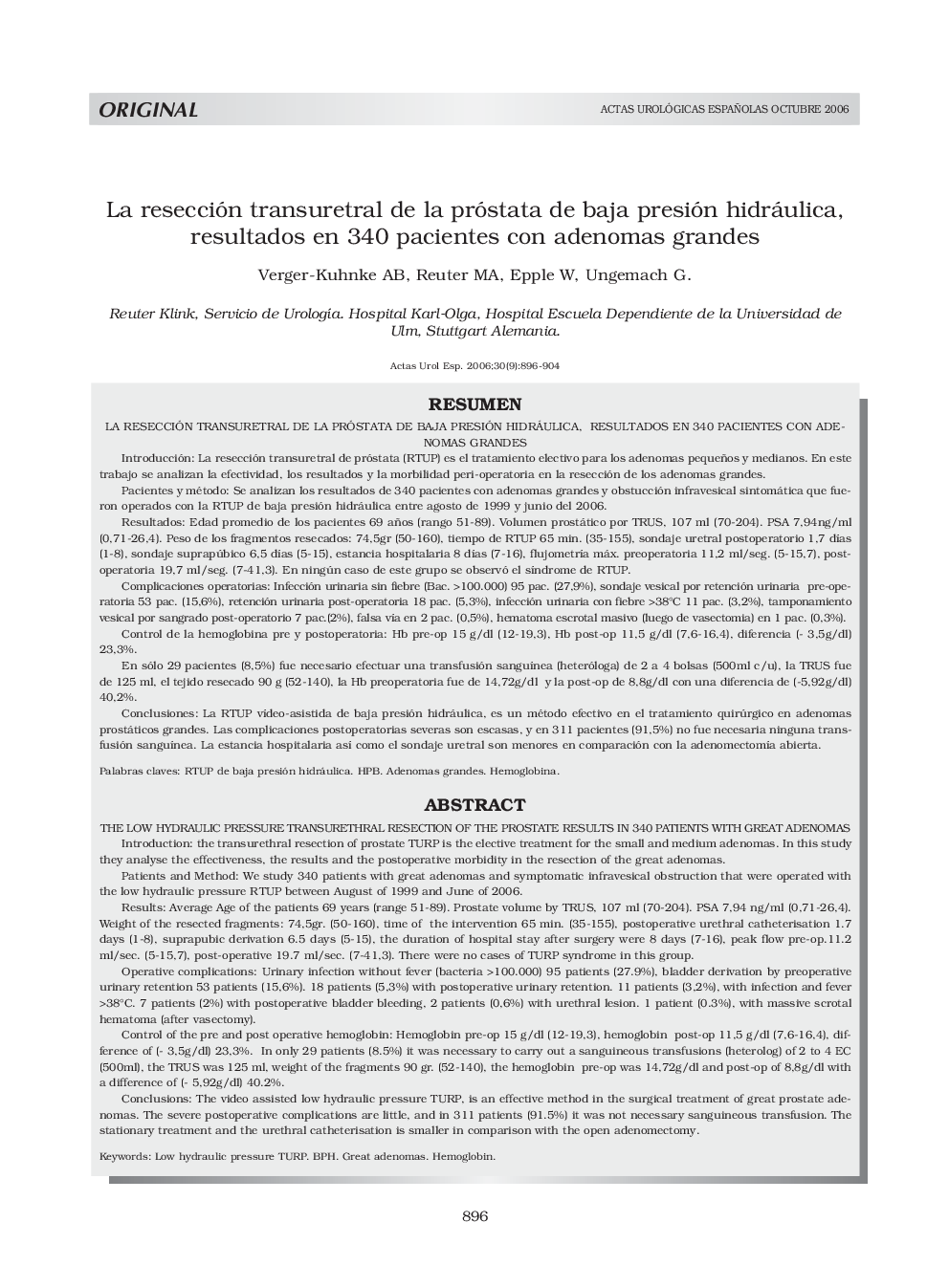| کد مقاله | کد نشریه | سال انتشار | مقاله انگلیسی | نسخه تمام متن |
|---|---|---|---|---|
| 3844561 | 1248157 | 2006 | 9 صفحه PDF | دانلود رایگان |

ResumenIntroducciónLa resección transuretral de próstata (RTUP) es el tratamiento electivo para los adenomas pequeños y medianos. En este trabajo se analizan la efectividad, los resultados y la morbilidad peri-operatoria en la resección de los adenomas grandes.Pacientes y métodoSe analizan los resultados de 340 pacientes con adenomas grandes y obstucción infravesical sintomática que fueron operados con la RTUP de baja presión hidráulica entre agosto de 1999 y junio del 2006.ResultadosEdad promedio de los pacientes 69 años (rango 51-89). Volumen prostático por TRUS, 107 ml (70-204). PSA 7,94ng/ml (0,71-26,4). Peso de los fragmentos resecados: 74,5gr (50-160), tiempo de RTUP 65 min. (35-155), sondaje uretral postoperatorio 1,7 dÃas (1-8), sondaje suprapúbico 6,5 dÃas (5-15), estancia hospitalaria 8 dÃas (7-16), flujometrÃa máx. preoperatoria 11,2 ml/seg. (5-15,7), postoperatoria 19,7 ml/seg. (7-41,3). En ningún caso de este grupo se observó el sÃndrome de RTUP. Complicaciones operatorias: Infección urinaria sin fiebre (Bac. >100.000) 95 pac. (27,9%), sondaje vesical por retención urinaria pre-operatoria 53 pac. (15,6%), retención urinaria post-operatoria 18 pac. (5,3%), infección urinaria con fiebre >38°C 11 pac. (3,2%), tamponamiento vesical por sangrado post-operatorio 7 pac.(2%), falsa vÃa en 2 pac. (0,5%), hematoma escrotal masivo (luego de vasectomia) en 1 pac. (0,3%). Control de la hemoglobina pre y postoperatoria: Hb pre-op 15 g/dl (12-19,3), Hb post-op 11,5 g/dl (7,6-16,4), diferencia (- 3,5g/dl) 23,3%. En sólo 29 pacientes (8,5%) fue necesario efectuar una transfusión sanguÃnea (heteróloga) de 2 a 4 bolsas (500ml c/u), la TRUS fue de 125 ml, el tejido resecado 90 g (52-140), la Hb preoperatoria fue de 14,72g/dl y la post-op de 8,8g/dl con una diferencia de (-5,92g/dl)40,2%.ConclusionesLa RTUP vÃdeo-asistida de baja presión hidráulica, es un método efectivo en el tratamiento quirúrgico en adenomas prostáticos grandes. Las complicaciones postoperatorias severas son escasas, y en 311 pacientes (91,5%) no fue necesaria ninguna transfusión sanguÃnea. La estancia hospitalaria asà como el sondaje uretral son menores en comparación con la adenomectomÃa abierta.
Introductionthe transurethral resection of prostate TURP is the elective treatment for the small and medium adenomas. In this study they analyse the effectiveness, the results and the postoperative morbidity in the resection of the great adenomas.Patients and MethodWe study 340 patients with great adenomas and symptomatic infravesical obstruction that were operated with the low hydraulic pressure RTUP between August of 1999 and June of 2006.ResultsAverage Age of the patients 69 years (range 51-89). Prostate volume by TRUS, 107 ml (70-204). PSA 7,94 ng/ml (0,71-26,4). Weight of the resected fragments: 74,5gr. (50-160), time of the intervention 65 min. (35-155), postoperative urethral catheterisation 1.7 days (1-8), suprapubic derivation 6.5 days (5-15), the duration of hospital stay after surgery were 8 days (7-16), peak flow pre-op.11.2 ml/sec. (5-15,7), post-operative 19.7 ml/sec. (7-41,3). There were no cases of TURP syndrome in this group. Operative complications: Urinary infection without fever (bacteria >100.000) 95 patients (27.9%), bladder derivation by preoperative urinary retention 53 patients (15,6%). 18 patients (5,3%) with postoperative urinary retention. 11 patients (3,2%), with infection and fever >38°C. 7 patients (2%) with postoperative bladder bleeding, 2 patients (0,6%) with urethral lesion. 1 patient (0.3%), with massive scrotal hematoma (after vasectomy). Control of the pre and post operative hemoglobin: Hemoglobin pre-op 15 g/dl (12-19,3), hemoglobin post-op 11,5 g/dl (7,6-16,4), difference of (- 3,5g/dl) 23,3%. In only 29 patients (8.5%) it was necessary to carry out a sanguineous transfusions (heterolog) of 2 to 4 EC (500ml), the TRUS was 125 ml, weight of the fragments 90 gr. (52-140), the hemoglobin pre-op was 14,72g/dl and post-op of 8,8g/dl with a difference of (- 5,92g/dl) 40.2%.ConclusionsThe video assisted low hydraulic pressure TURP, is an effective method in the surgical treatment of great prostate adenomas. The severe postoperative complications are little, and in 311 patients (91.5%) it was not necessary sanguineous transfusion. The stationary treatment and the urethral catheterisation is smaller in comparison with the open adenomectomy.
Journal: Actas Urológicas Españolas - Volume 30, Issue 9, 2006, Pages 896-904